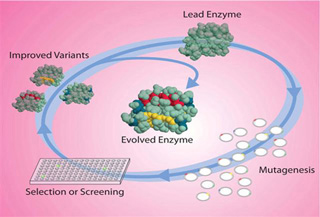
The two essential steps of directed evolution of enzymes are: (1) mutagenesis of the gene encoding enzyme, and (2) selection of a particular variant based on desired properties. (Image courtesy of Tom diCesare.)
Instructor(s)
Dr. Kerry Love
MIT Course Number
7.344
As Taught In
Spring 2008
Level
Undergraduate
Course Description
Course Features
Course Description
Directed evolution has been used to produce enzymes with many unique properties. The technique of directed evolution comprises two essential steps: mutagenesis of the gene encoding the enzyme to produce a library of variants, and selection of a particular variant based on its desirable catalytic properties. In this course we will examine what kinds of enzymes are worth evolving and the strategies used for library generation and enzyme selection. We will focus on those enzymes that are used in the synthesis of drugs and in biotechnological applications.
This course is one of many Advanced Undergraduate Seminars offered by the Biology Department at MIT. These seminars are tailored for students with an interest in using primary research literature to discuss and learn about current biological research in a highly interactive setting. Many instructors of the Advanced Undergraduate Seminars are postdoctoral scientists with a strong interest in teaching.


